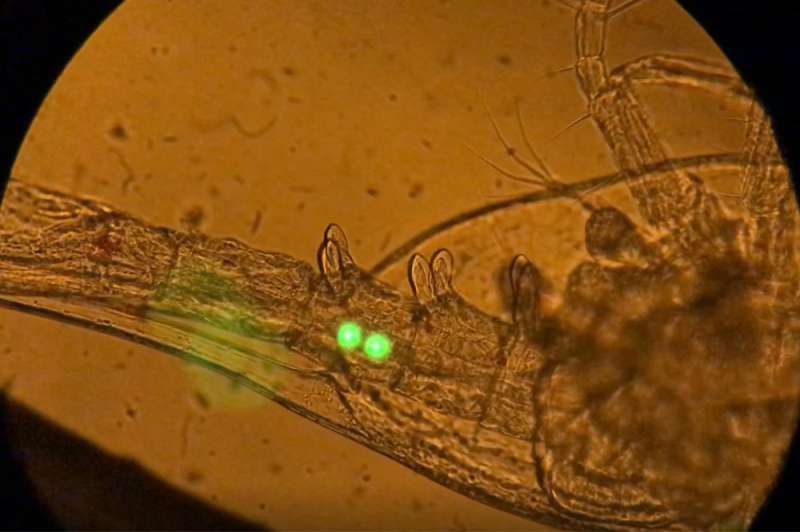Microplastic passing through a copepod's digestive system under the microscope Credit: PML
Microplastics have been recorded in a range of zooplankton species, and they are already causing problems for these tiny - but vitally important - animals, even before the plastic particles make their way through the food web. A new review suggests that, to further our understanding of when and why zooplankton munch on microplastics, experiments need to better represent the tiny plastic particles actually found in the marine environment.
Zooplankton is the small animal life that inhabits the open ocean. It comes in many forms, from copepods and jellies to the tiny larval stages of larger marine animals such as fish and crabs. This plankton soup of millions of tiny organisms is the prey of choice for a range of marine species, and forms a key part of the lower levels of the food web. Once ingested, microplastics will enter the web and can potentially be transferred up it as individuals are caught and consumed by ever-larger predators.
In a comprehensive review on the effects and bioavailability of microplastics, conducted by scientists at PML, 39 zooplankton species have been found with microplastics in their digestive system. Almost half of studies included in the review found their plastic-consuming zooplankton subjects to exhibit some form of negative effects, be it impacts on their feeding or reproductive behaviours, growth and development, or even as severe as affecting their lifespan. In contrast, only three studies reported no negative effects in zooplankton species that had been dining on plastic.
But what appears to influence the ingestion of these microscopic particles by zooplankton? A range of physical and biological factors can play a part, including the size, shape and age of the microplastics, as well as the overall abundance in the water. The majority of studies investigating this particular plastic problem involved laboratory conditions, and while these studies have been essential in exploring marine plastic pollution and advancing our knowledge of microplastic abundance and ingestion, they might not have involved plastic particles representative of how they would appear in the natural world. Shaped and weathered by water and waves, microplastics found in the marine environment are often different in their type, appearance and age compared to those used in experiments.
And it is these factors that will be further explored, says PhD student Zara Botterell, lead author of the new paper: "Investigating the factors which affect the bioavailability of microplastics to zooplankton - such as shape, size and age - will help to address key knowledge gaps regarding microplastic ingestion in the natural environment. This is essential to understanding potential effects on species populations and broader economic consequences such as impacts on fisheries."
Dr Penelope Lindeque, senior author on the paper, added: "From our work at Plymouth Marine Laboratory over the years we have sadly found microplastic in nearly all the species of marine animals we have looked at; from turtles, dolphins and fish larvae, down to the tiny zooplankton at the base of the marine food web. Our studies provide evidence that we all need to help reduce the amount of plastic waste released to our seas and maintain clean, healthy and productive oceans for future generations."
More information: Zara L.R. Botterell et al. Bioavailability and effects of microplastics on marine zooplankton: A review, Environmental Pollution (2018). DOI: 10.1016/j.envpol.2018.10.065
Journal information: Environmental Pollution
Provided by Plymouth Marine Laboratory























